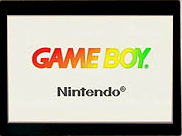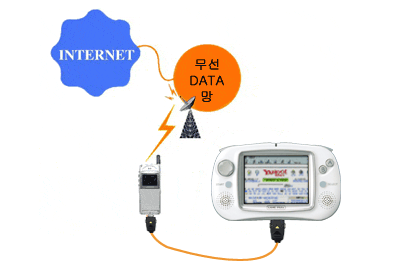THE BATTLE OF THE CENTURY!!!
GAMEPARK32 vs GAME BOY ADVANCE
Nintendo is currently the handheld giant. They have been for ten
years. Countless systems fought for space in the handheld market, only
to be killed off by the dark lord. NeoGeo Pocket, Game Gear,
WonderSwan... all crushed under the Game Boy's giant thumb. Which is why I'm
so big about the GP32 making it over here. Maybe it'll take some of
the wind out of the Game Boy sail. No competition is unhealthy,
especially if you've had none for 10 years. It's time for the GP32 to
whip the GBA into shape!
SYSTEM SIZE

Above, you can see an actual-sized picture of the GamePark32,
courtesy of GamePark.com, with a thick blue line surrounding it. That
thick blue line is an outline of an actual-size GBA. As you can see, the
GP32 is a little smaller around the sides, but the GBA is smaller along
the bottom, probably because there are big stereo speakers on opposing
sides of the GP32. Still, they're pretty much the same size (even though the design of the GP32 makes it a little bigger along the bottom) so I'll have to call this a draw.
SCREEN SIZE

Above is a picture of the 2.9" GBA screen against the 3.5" GP32
screen. There's more to the GP32 screen that meets the eye. As well as
being almost a whole inch bigger, the screen resolution is higher, too.
While the GBA's res is only 240x160, the GP32's is 320x240! As well, the
GP32 screen's color pallette is a lot higher too. In 16-bit mode, it can
display all it's colors at once: 65,536! The same as a $3-or-$400
Handspring Prism pocket PC! But in 8-bit mode, it can only display 256
colors at once, while the GBA can display 512 at once out of it's
32,768-color pallatte. Plus, neither of them are backlit, which is a
good idea and a bad idea. Without a backlight, it's a lot smaller and it
really adds to the battery life. But without one, you can't play it at
night without a light that attaches onto it or a sufficient light source
when you want to play it. My personal favorie is the sun or the Interact
GlowGuard (GBA light). But still, the pros of the GP32's TFT outmeasure
the one con. Not to mention, the GP32 doesn't have that annoying flat
piece of plastic protecting it that scratches so easy and is extremely
prone to fingerprints. Jack up another point for the GP32!
SOUND
OK, this is the part where
the Game Boy Advance waves the white flag and crawls into a cave to die
a long, slow death. In case you haven't noticed, the GBA's sound system
has been exactly the same as it was in 1989!!! OK, maybe the sound chip
in the GBA is an improvement over the 'taller-than-wide' incarnations
like the GBC and GB Pocket, but the speaker has remained exactly the
same: a crappy, tiny mono speaker that might as well not even be there
when you're in a moving car or on a flushing toilet. Nintendo makes up
for this with a headphone jack. But for us who have an annoying little
brother who's obsessed with ducks and guards his stuff like a lioness
guards her cubs, 16-bit PCM stereo sound would be a good thing.
4-channel mixing and WAV and MP3 support don't exactly hurt either. But
if you have headphones... then there's a headphone jack on the GP32 too.
Scared ya, didn't I? Didn't I?!
BATTERY LIFE
This is the one category where the GP32 is lagging behind. While GBA
goes for 15 hours on two AA batteries (more if you get a better brand),
while the GP32 goes for 12˝ hours on two AAs. Sure, it's not much, but
2˝ hours might be the difference between portable entertainment and
beat-your-head-on-the-window bordem on the remaining distance home from
the family road trip!
MULTIPLAYER

I'm not really sure which is better in this case. As told by the
picture above, the GP32 can let up to four people play at once (well, it
doesn't show that, but I know it can) with no link cable from up
to 10m (30 feet) away! But with the GBA, you need at least one link
cable to play a two-player game, and more if you want more then two
players. At least, that's how it is with Nintendo's link cable. Now,
companies like Nyko are making these
kick-butt four-player cables so that you don't need to spend $15 on
three Nintendo cables! But that's not the point. As well, with certain
GBA games, you only need one cart to play a multiplayer game, but I'm
not sure that the same is true with the GP32. It took Nintendo 10 years
to overcome the 'multi-cart' hurdle with wires, so I'm not entirely sure
they've pulled it off without wires yet. On a less sure note, I might
think that wireless portable multiplayer gaming isn't that reliable, but
I'm pretty sure I'll be proven wrong on that.
SOFTWARE FORMAT

Uh... I never expected this. The GBA is kicking the GP32's butt in
one category! While GBA carts can hold up to 8MB of computer memory,
around the same as a Chrono Trigger cart, GP32 'Smart Media Cards' can only hold
around 512KB, or ˝MB, about the same as a 1992-94 NES
cart and some SNES carts. This probably means that it will be extremely
difficult, maybe impossible, to make remakes of SNES games on the GP32,
but a breeze to make NES remakes on it instead. So if you prefer NES
games over SNES (I, personally, prefer SNES), then the GP32 is for you!
However, for original ideas, the size usually doesn't matter. Look at
this video of
Little Wizard! GamePark probably made the cartridges like that so
thet they would be easy to develop for. If MIT freshmen could make
games for this system, then I'm sure big-time developers like Capcom and
Ubi Soft would find this to be as easy as breathing! Plus, similar to
the 'Mapper' enhancement chips in NES carts, developers might find ways
to work around the smart card's limited memory! Not to mention it may be
much, much cheaper then GBA's $60-$70 cart. But still, none of this has
been determined, so I'll have to give this point to the GBA for their
bigger cart.
CPU AND RAM
...I couldn't really decide who would win on this one, since I know
very little about ARM CPUs and RAM. Anyway, the GP32 has an ARM 9 CPU
with 8MB of embedded SDRAM. As for the GBA, it has 128KB VRAM embedded
into it's ARM CPU, and 256KB of WRAM by itself, totalling 352KB RAM,
significantly less then the GP32's RAM, but I'm not sure if I should
give points for that. The GP32 might have more, but maybe the GBA has a
better kind of RAM, so I can't award either of them a win for that. As
for the CPU, they're much the same, but CPU speed doesn't matter towards
great games. Take Super Street Fighter II Turbo for the SNES. That could
go blazing fast on the SNES's slow CPU (I don't exactly know how fast it
is). Whatever. I can't decide. Draw!
INTERNET

What's this I see? Yahoo! on a giant 3.5" screen? Not to mention the
GP32's high res will make it easier to browse with less scrolling. As
for the GBA, in Japan you can buy this thing called the Mobile Adapter
GB (which is also compatible with the GBC) which plugs into the GBA's
link cable and into a mobile modem phone. With the GP32, there's no link
cable port to blog up and prevent multiplayer gaming because there's a
special port on the bottom of the GP32 that plugs into your modem phone
so you can browse on the road! There's another method, but I couldn't understand it, so I left it on the home page for you to see. Plus, since the Mobile Adapter GB never
made it stateside, the GP32 will be the answer! Another point!
FINAL SCORE
GP32: 7 - GBA: 5
There you have it! The GP32 leaves the arena a winner! But it's
shortcomings might not make it high and mighty, and instead give the GBA
some healthy competition. I'm not sure what determines what you'll buy.
Be it the original games, be it that it's perfect for NES remakes, be it
it's bigger screen size, be it it's better sound, be it whatever! It's
clear that the battle is won, but the war won't be won unless GamePark
is convinced that there is sufficient market venue stateside! What will
YOU choose?!




